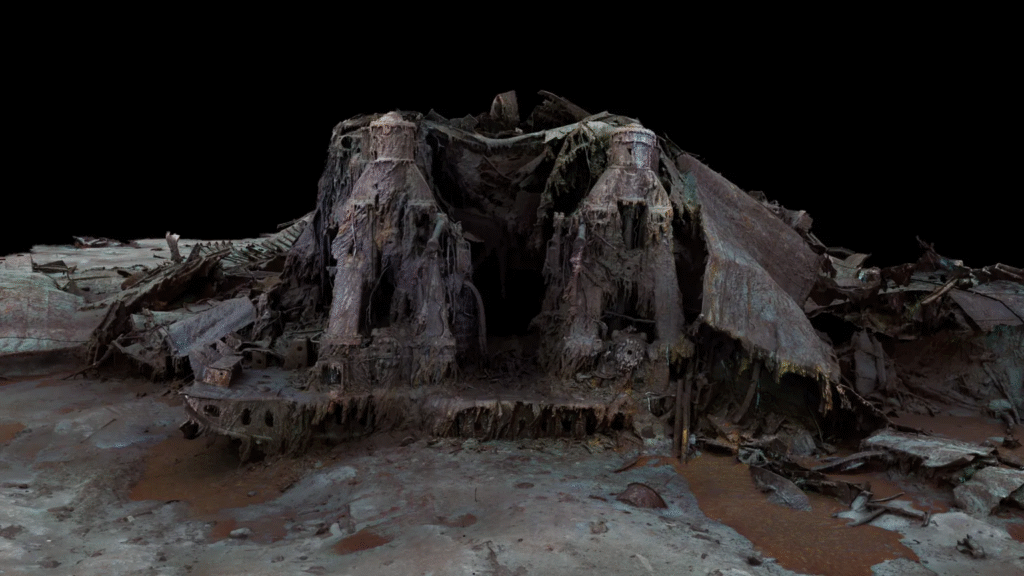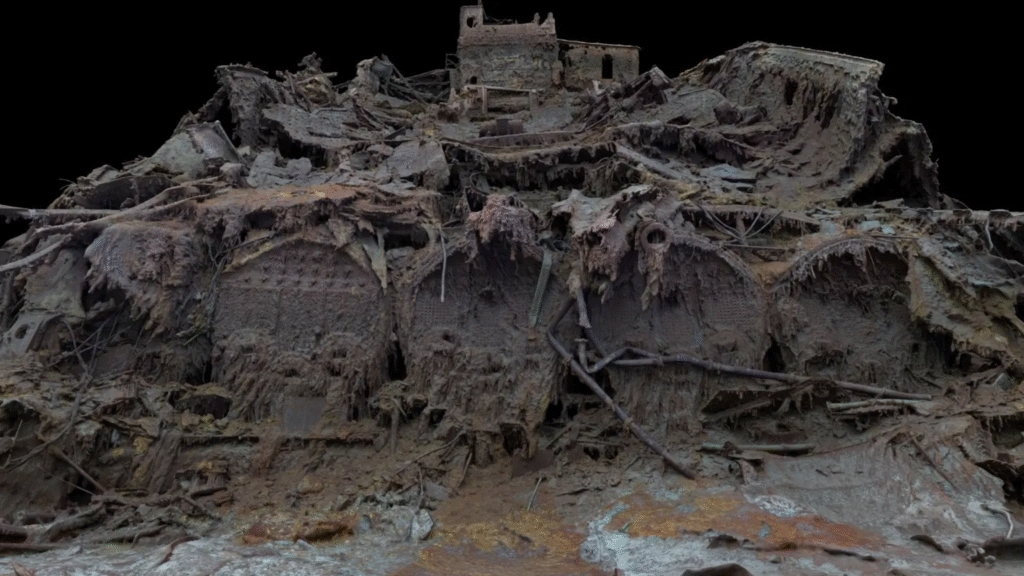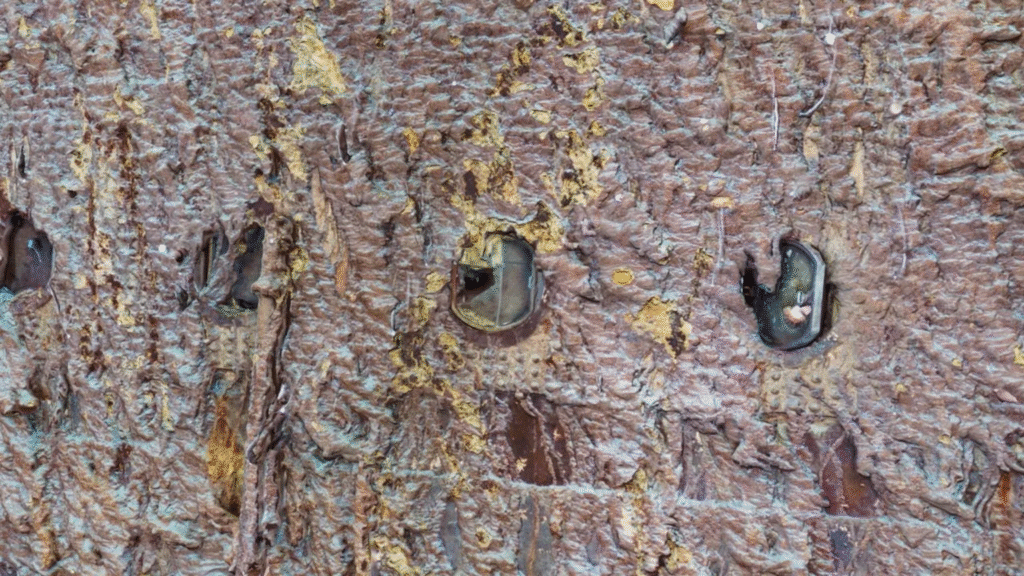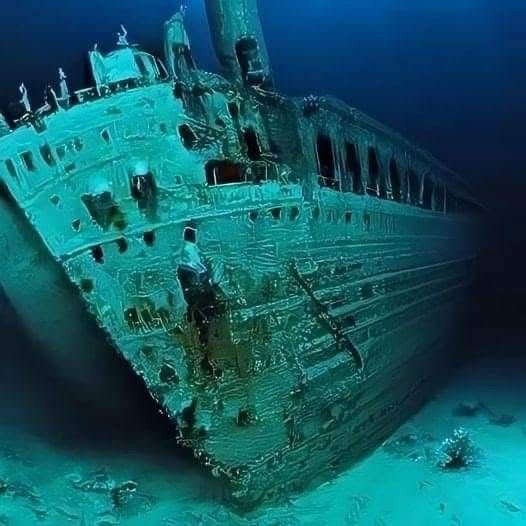Over a century after it vanished beneath the icy waters of the Atlantic, the Titanic continues to speak. Now, thanks to the most detailed digital scan ever created, the world’s most famous shipwreck is revealing new truths—ones that eyewitnesses, survivors, and investigators could only guess at for decades.
This full-sized 3D model of the Titanic allows researchers and the public alike to view the wreck in astonishing clarity. It exposes not only the physical damage sustained during the tragic sinking, but also offers subtle, powerful clues about the final acts of courage, sacrifice, and survival on that fateful April night in 1912.
A Complete View of the Wreck—For the First Time
The Titanic lies over two miles beneath the ocean’s surface, making it one of the least accessible shipwrecks ever discovered. Until now, efforts to understand it have been limited to submersible dives and grainy images, offering only fragmented views.
But in 2023, more than 700,000 images were stitched together using advanced scanning technology and underwater robotics to create a full 3D reconstruction of the ship. Known as a “digital twin,” this model captures the Titanic in its entirety—bow to stern—like never before.
The scan was produced for a new documentary, Titanic: The Digital Resurrection, by National Geographic and Atlantic Productions.

The Break-Up: A Brutal End Captured in Metal
One of the most haunting aspects of the digital model is the clear evidence of how the Titanic tore in half as it sank.
The bow section, which broke off first, now rests on the seafloor relatively intact—its pointed tip still upright, eerily preserving the ship’s once-graceful profile. The stern, however, tells a very different story. Thrown into a violent spiral as it detached and plunged, the rear of the ship is a tangled, crumpled mess of twisted steel and shattered structure.
Massive engines can be seen lying exposed, their towering forms surrounded by layers of collapsed decks and mangled pipes. These engines once powered what was considered a marvel of human engineering.
“Titanic is the last surviving eyewitness to the disaster,” said Titanic historian Parks Stephenson. “And she still has stories to tell.”
Heroism in the Boiler Rooms: New Evidence Supports Survivor Accounts
Among the most poignant revelations from the scan is the preserved state of one of Titanic’s boiler rooms—an area previously inaccessible to both cameras and divers. The room lies at the break point where the ship split, at the rear of the bow section.
Eyewitness accounts from survivors recalled how, as the ship slipped beneath the surface, the lights remained on—a small, flickering hope amid chaos and darkness. Many attributed this to the engineering team, led by Chief Engineer Joseph Bell, who reportedly stayed behind to keep power flowing as long as possible.
Now, the scan shows concave boilers, an indication that they were likely active when submerged. Even more telling is a valve on the stern, captured in an open position—strong visual evidence that steam was still being delivered to the generators as the ship began its descent into the deep.
“They kept the power on to the end,” said Stephenson. “So that lifeboats could be launched with light. That open valve? It symbolizes their final act of duty and bravery.”
Small Holes, Big Consequences: New Simulation Models the Damage
While the visual scan helps reveal the ship’s condition now, a new computer simulation is helping answer the most persistent question: How did the Titanic sink so quickly after striking the iceberg?
Led by Professor Jeom-Kee Paik at University College London, a team of naval architects used the Titanic’s original blueprints, speed, and direction to build a high-detail simulation of the collision. Using powerful computing models, they reconstructed the ship’s contact with the iceberg.
Contrary to the dramatic image of a massive gash, the simulation reveals something more subtle—and far more deadly: a line of small punctures, each about the size of a sheet of paper, running along six of the ship’s forward compartments.
The Titanic was designed to remain afloat with four compartments breached. But six? That pushed the vessel beyond its limits.
“It was a series of small wounds that ultimately led to a catastrophic loss,” said Simon Benson, a naval architecture expert from the University of Newcastle. “The water crept in gradually, but across a wide stretch of the hull. It was the slow, unstoppable flooding that doomed her.”
This crucial damage is hidden beneath deep layers of sediment, so it cannot be seen in the scan. But the simulation confirms survivor accounts that the ship struck only a glancing blow—yet it was more than enough.
Details in the Darkness: Portholes, Cranes, and the Toll of Time

The clarity of the 3D model has also made it possible to see smaller features of the Titanic in remarkable detail.
One image shows four portholes still set into the hull of the bow—three with their original glass intact. The fourth is shattered, with a hole where the glass once was, likely caused during the iceberg collision. Survivors recalled ice coming through their windows during the impact; this broken porthole aligns with those memories.
Elsewhere, the promenade deck is clearly visible, as are lifeboat davits, deck cranes, and even crew quarters. On the bow, the ship’s front crane remains in place, a rust-covered sentinel now standing guard over a sunken time capsule.
Rust-colored textures known as “rusticles”—formed by sea life that feeds on the iron—cover much of the ship. These formations give the wreck a rippled, ghostly appearance. The sea continues its slow, quiet process of reclaiming the metal.

A Crime Scene Underwater: Piecing Together a Human Story
Parks Stephenson likens the Titanic wreck to a crime scene, frozen in time.
“To understand what happened, you have to see everything in context,” he said. “This full scan gives us that context for the first time.”
Personal items—suitcases, shoes, and even teacups—can still be seen among the debris. They serve as silent witnesses to lives disrupted and lost.
Though the wreck was discovered decades ago, this new digital model allows experts to revisit it with fresh eyes and modern tools. And yet, despite the technological leap forward, Stephenson is quick to remind us that the Titanic still holds secrets.
“She’s only giving her stories to us a little bit at a time,” he said. “And every time, she leaves us wanting more.”
A Glimpse into the Past, A Lesson for the Future
This immersive scan doesn’t just offer scientific insights—it reconnects us with the human story of the Titanic.
From the engineers who stood their ground in the boiler rooms, to the small structural weaknesses that brought down a so-called unsinkable ship, every detail tells us more about the courage, tragedy, and fragility that marked that cold April night.
As the 3D model continues to be studied in the years ahead, it may reshape our understanding of the event entirely. But one thing is already certain: Titanic is not just a shipwreck. It’s a lasting reminder of human resilience—and a story still unfolding.



